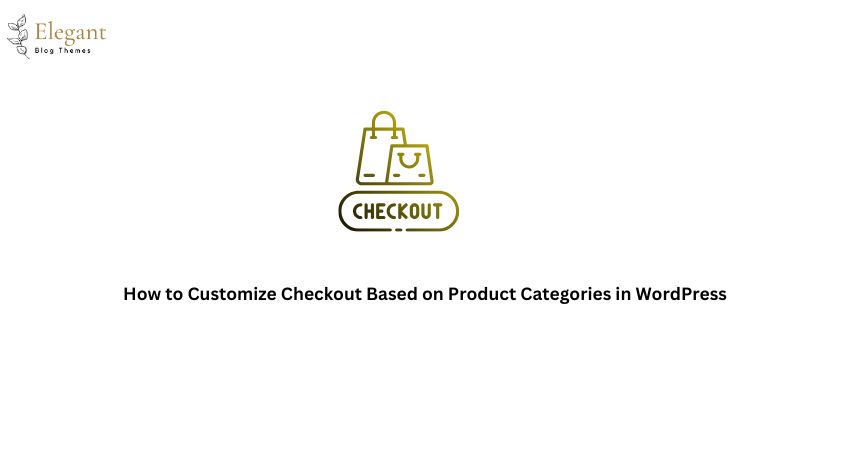Customizing the checkout process based on product categories can make your WordPress store more user-friendly and sales-driven. Whether you want to apply different shipping methods, add special instructions, or show unique fields, tailoring the checkout experience by product category helps you meet your customers’ needs.
This guide will show how to customize the WordPress checkout process for product categories.
Steps to Customize Checkout Based on Product Categories
Let’s solve this using simple methods.
Step 1: Assign Products to Categories
First, make sure your products are organized into categories.
- Log in to your WordPress dashboard.
- Go to Products > Categories in the WooCommerce menu.
- Add new categories or edit existing ones.
- Assign each product to the relevant category.
Organizing products by category is essential for this customization to work.
Step 2: Install and Activate a Code Snippet Plugin
You’ll need to add custom code to make these changes. Instead of editing theme files, use a plugin to add snippets safely.
- Go to Plugins > Add New in your dashboard.
- Search for Code Snippets or a similar plugin.
- Install and activate the plugin.
This plugin makes adding and managing custom code easy without touching your theme files.
Step 3: Add Custom Code for Checkout Fields
Add code to show or hide checkout fields based on product categories.
Example: Add a Special Field for a Specific Category
If you want to show a custom field only when products from a specific category are in the cart, use this code:
add_filter(‘woocommerce_checkout_fields’, ‘add_custom_checkout_field’);
function add_custom_checkout_field($fields) {
if (WC()->cart->is_empty()) return $fields;
// Check if the cart has products from a specific category
foreach (WC()->cart->get_cart() as $cart_item) {
$product_id = $cart_item[‘product_id’];
if (has_term(‘your-category-slug’, ‘product_cat’, $product_id)) {
$fields[‘billing’][‘billing_special_instructions’] = array(
‘type’ => ‘textarea’,
‘label’ => __(‘Special Instructions’),
‘placeholder’ => __(‘Add your instructions here’),
‘required’ => false,
);
break;
}
}
return $fields;
}
- Replace your-category-slug with your product category slug.
- Add this code using the Code Snippets plugin.
- Save and activate the snippet.
Step 4: Customize Shipping Methods by Category
If you want to enable or disable specific shipping methods based on product categories, use this code:
add_filter(‘woocommerce_package_rates’, ‘custom_shipping_by_category’, 10, 2);
function custom_shipping_by_category($rates, $package) {
$allowed = false;
// Check if products belong to a specific category
foreach ($package[‘contents’] as $cart_item) {
$product_id = $cart_item[‘product_id’];
if (has_term(‘your-category-slug’, ‘product_cat’, $product_id)) {
$allowed = true;
break;
}
}
if ($allowed) {
// Only keep specific shipping methods
foreach ($rates as $rate_id => $rate) {
if ($rate->method_id !== ‘flat_rate’) { // Keep only flat rate shipping
unset($rates[$rate_id]);
}
}
}
return $rates;
}
This code restricts shipping methods based on product categories. To allow a specific method, replace your-category-slug with the desired category and adjust flat_rate to the desired method.
Step 5: Add Category-Specific Checkout Messages
To display a message during checkout based on the product category, use this code:
add_action(‘woocommerce_review_order_before_payment’, ‘category_based_checkout_message’);
function category_based_checkout_message() {
foreach (WC()->cart->get_cart() as $cart_item) {
$product_id = $cart_item[‘product_id’];
if (has_term(‘your-category-slug’, ‘product_cat’, $product_id)) {
echo ‘<p style=”color: red;”>Note: Items in this category require extra packaging time.</p>’;
break;
}
}
}
This displays a custom message on the checkout page when products from the specified category are in the cart.
Step 6: Test Your Changes
After adding the code snippets, test your checkout process:
- Add products from the target category to the cart.
- Proceed to checkout and verify the changes.
- Test with products from other categories to ensure the changes don’t affect them.
Review the code or check for conflicts with other plugins if something doesn’t work.
Conclusion
Customizing the checkout process in WordPress based on product categories improves your customers’ experience and simplifies their journey. By organizing products, using a snippet plugin, and adding targeted code, you can tailor the checkout page to fit your store’s needs.
